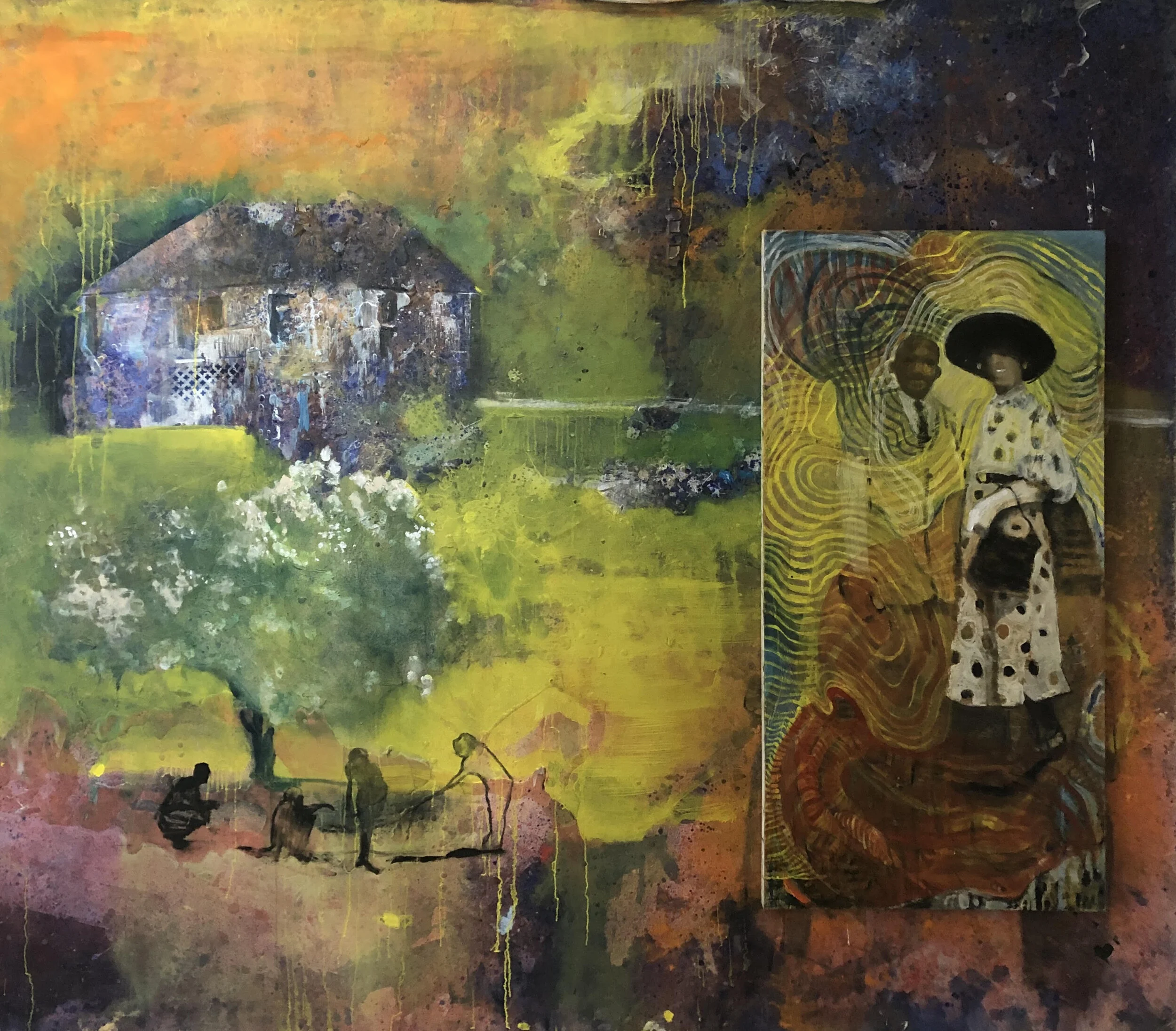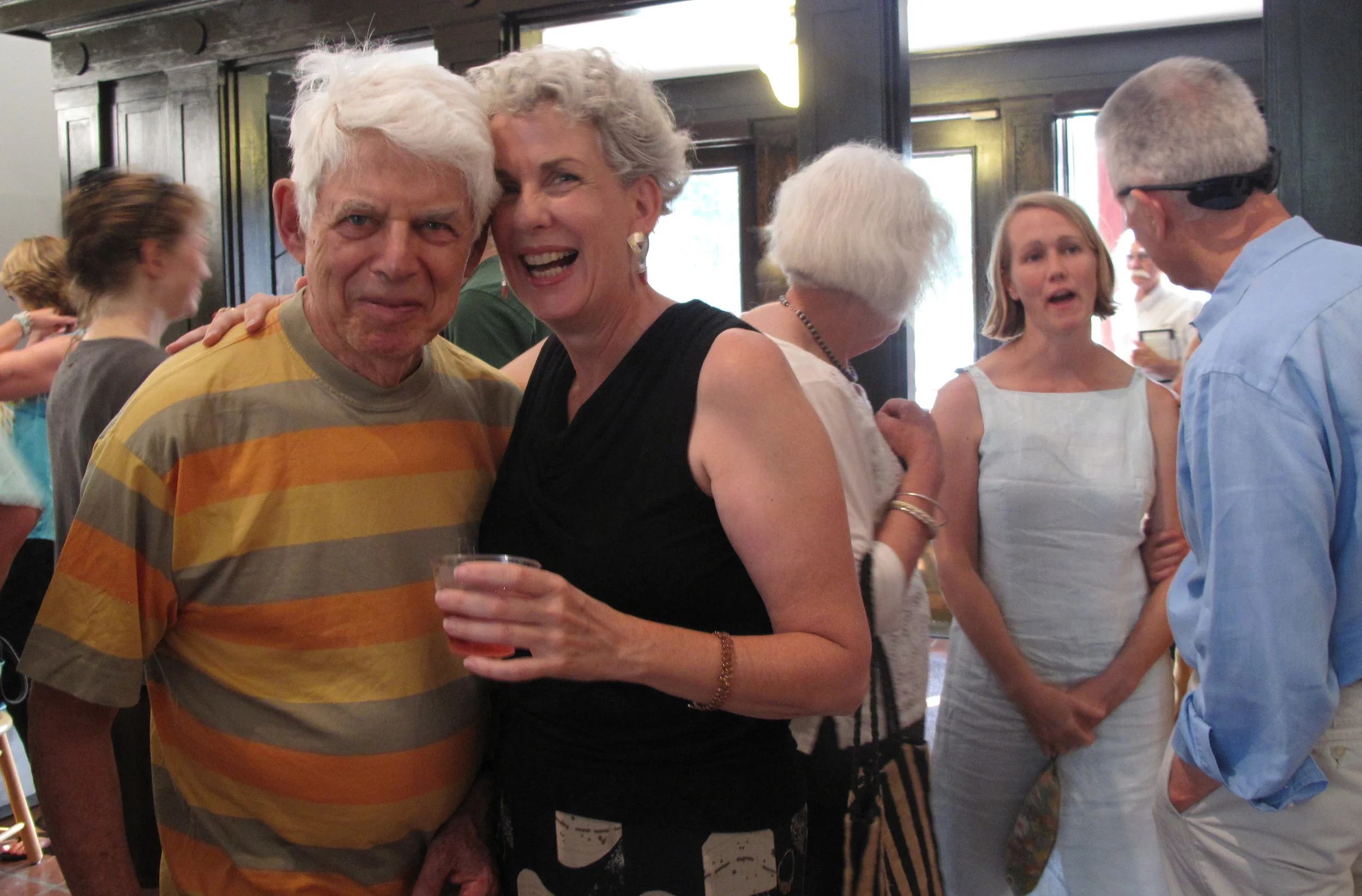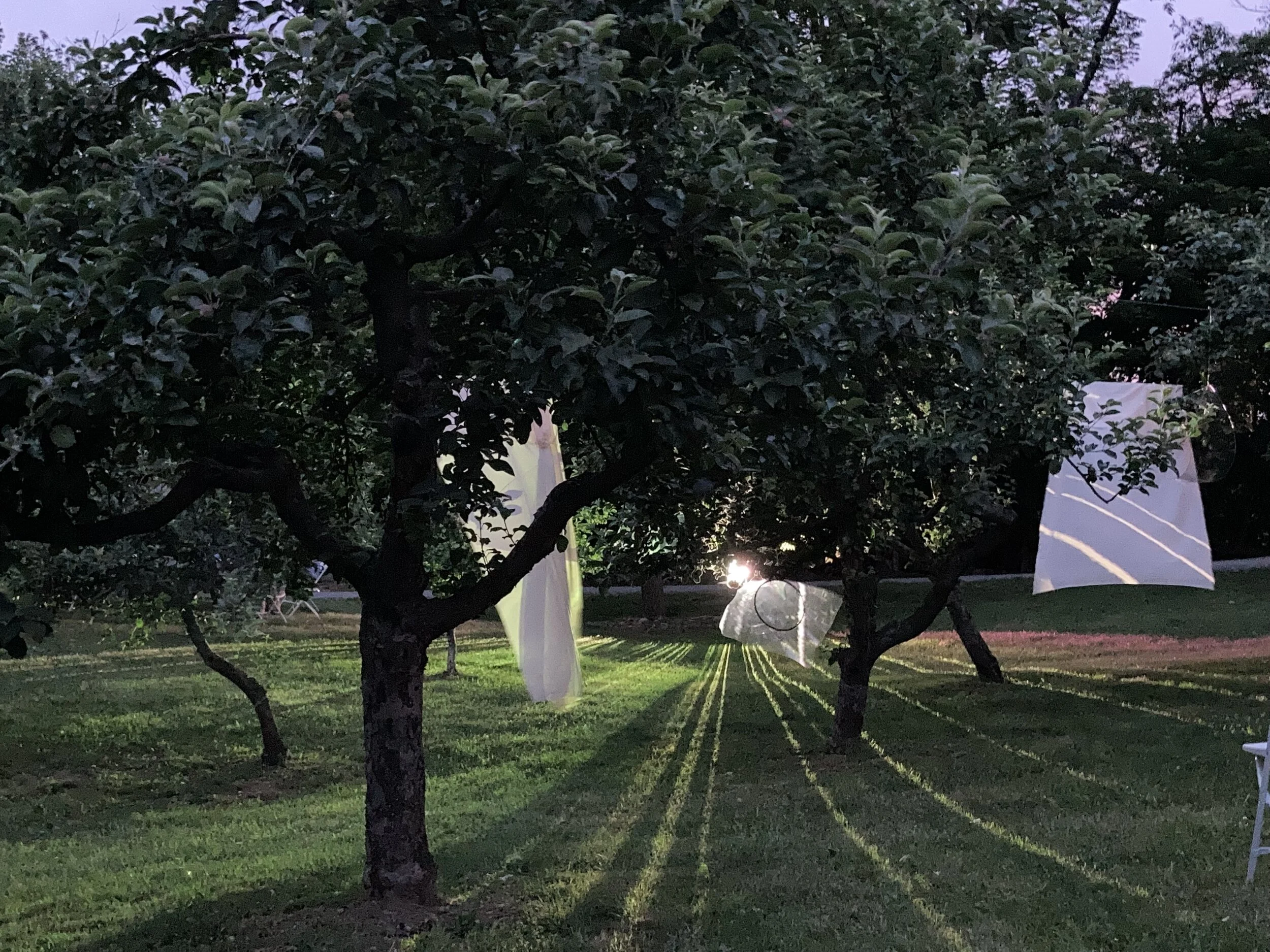“Still proud to be American”
Joseph Diggs and I grew up together on Cape Cod, and our families have known each other since the 1970s. We did a show at BMAC in 2019 called Joseph Diggs: Proud 2 Be American, based on two bodies of work Joe created. The first relates to the African American descendants of slaves on the Diggs side of his family, who have a long tradition of service in the American armed forces. The other side of the family is mostly from the Cape Verde Islands. These ancestors came to the United States as free men and women and have been successful entrepreneurs for generations.
Joe’s paintings feature swooping brushstrokes, glancing lines, and swaths of dripping paint. They are complicated compositions in which faces, text, and symbols provide clues to the place of the artist’s family in the history of our country.
— BMAC Chief Curator Mara Williams
Williams: Joe, my brothers brought me back into your world when they championed your work to me. They said I had to see what you were doing. I started making visits to your studio, and I fell in love with your work. That’s how you and I reconnected after 30 years of not seeing each other. I brought your work forward because I think it’s incredibly powerful, and it also reminded me how frequently we overlook rich and varied human experiences that we’re bumping up against, shoulder to shoulder.
In light of recent events, how is your past relationship with this body of work and this idea of being “Proud 2 Be American” being brought forward? How has that changed for you—or has it stayed the same?
Diggs: It’s an affirmation that what I painted is relevant. I’m still proud to be American. These are difficult times, but what is exciting is they’ve brought the white community into discussions my community has been having about structural racism for decades. I hope these discussions are going to galvanize our country and make us even stronger and better, as we keep realizing that we’re more the same than we are different. The movement that’s happening now is a reflection of what I’ve been exploring in paint. Black and Brown Americans have a rich history in our own community as well as in service to our country; we have also had to face the brutality and inequity of 401 years of oppression. It’s heartening to see that white people are coming to this understanding. I’m proud to be American because even though we have our problems, we’re conjoined in the fact that we’re trying to make a better world.
Joseph Diggs, "An American Tragedy" (2019), acrylic and resin on panel, 78 x 18 inches
Williams: “An American Tragedy” was the piece that I felt was a coda to our show at BMAC, and it didn’t come out of the Diggs or Cape Verdean bodies of work. It was an elegy about the murder of James Byrd Jr. It’s a very abstract piece. It was the only painting in the show that directly referenced the extra-judicial killing of a Black man. What does that piece mean to you?
Diggs: When I read an article about James Byrd Jr.’s death, it was one of those moments of my life that I’ll never forget. The profound pain that I felt was shocking. I wanted to capture, in abstract form, what is lost when life vanishes through hate. After picking Mr. Byrd up to give him a ride, three white guys decided to lynch him by dragging him tethered to the back of their truck. The photograph of his body parts scattered across the road and chalk-marked became my symbol of the soul. The Byrd elegy is the glue of “Proud 2 Be American” and of my work in general.
Joseph Diggs, "Chalk Line Baller" (2016), oil on canvas, 72 x 45 inches
Williams: In your painting “Chalk Line Baller,” we see chalk lines on a baseball field.
Diggs: Yes, that relates to the death of the African American baseball player. There are relatively few African Americans in baseball today. It’s also an homage to those who have passed to get us to where we are right now, just to watch the dream fade again. It’s a constant circle. This is the pattern of life—it’s circular. My mark making is circular.
Williams: How do the violent deaths of George Floyd, Breonna Taylor, and others recently killed by police take up psychic space in your life, both as a Black man and as an artist?
Diggs: That’s a whole lot to talk about, to be honest with you. It’s exhausting, first of all. It’s very hard to be able to filter through all this information without just being reactive. I don’t want to just react. I need to take these things and digest them a little bit, and when it comes at me at this rate and pace, it’s hard to digest. It pushes me into an art content corner. It closes doors, because in this moment, painting the Black experience can seem like an obligation. Maybe sometimes I just want to paint a landscape.
What I have realized, though, is that this has opened me up to understand who I am even more deeply. I’ve found a way to combine my abstractions in an even larger format, from my perspective as an African American artist. I have to believe in my own strengths, alone in the studio.
Williams: Tell us a little bit about what you’re working on now. What’s on the kitchen table that you’re doodling on, what’s on your easel, and what’s on your studio wall?
Diggs: On the kitchen table, I have what I call my coronavirus series. It’s a collaboration with the people I’ve been sequestered with, three of us here who are weathering the storm. We sit and doodle. We talk about which direction to go, but we’re all just doodling. We end up doing this busy work to fill time. Within that, I realized that the daily routine of doing these little pieces has brought me to another spot of understanding detail atop of structure. I’ve always been a structural painter, first and foremost. Detail has never really been a part of my aesthetic. Overloading the structure with detail and then breaking it back down has been eye-opening.
I’ve also been using photographs of people from the past who have spent time on my property, introducing them into these Covid situations—bringing the past into the present to try to gain an idea of what the future might become. What Covid has done for my art is to help me unite all my different areas of focus into one larger conversation. So that’s what’s happening in the kitchen.
On the studio walls, I have a large canvas with a painting of the property that my grandfather had before me. I’m painting the cottages and bringing the images of those people back to the cottages, and applying the movements and swirling and layers of life on top. It’s a personal version of what I’m doing on my kitchen table.
On the easel, I have memories of the fabulous trip to Cuba that I took through the Brattleboro Museum & Art Center. You guys were fabulous, and I thank you, because it was life-changing. I’m working with the memory of the beauty of Cuba, and the memory of old and new. The freshness, the heat, and the warmth of the people and the place.
Williams: When we were in Cuba together, you had some interesting observations about the people there. Can you tell us more about that?
Diggs: I thought the Cuban people were exciting because they got along. I know they have prejudice, but it wasn’t an underlying tow on everything like it is in the United States. It didn’t feel like there was a separation or a polarity or a divisiveness. I found myself feeling more free than I do in my own country. Perhaps it’s because the streets were more populated with Black and Brown faces than where I live on Cape Cod. Being in Cuba was refreshing. It made the food taste better, it made the colors brighter, it made everything wonderful.
Recent work in progress, “Historical Referendums”
Williams: At this moment, is there something you would like us to know or ask us to consider?
Diggs: Yes—at this moment, especially, because this is an important time in the evolution of our country. When we look back at the death of Mr. Floyd and everybody before and after him, artists like me stand on the shoulders of artists who I think are incredible: artists like Mark Bradford, Keith Morris Washington, Steve Locke, Jack Whitten, Henry Ossawa Tanner, Kara Walker, Carrie Mae Weems—the list goes on and on. But in addition to the big names, there is art being made by professional artists across the country. I encourage viewers to take a look at what’s going on around the corner; look at what your neighbors have created. Meet your neighbors of all colors.
What we’re trying to bring out to the American people is very simple and very basic. Our best bet is to straighten this race thing out, and we have the opportunity. We are the leaders of the world as Americans. If you look across the global movement that’s happening now, this is our time to shine—I’m not saying it’s our time as Black people, I’m saying this is our time to shine as Americans. Let’s step up to the plate and make America the beautiful place that it has always had the potential of being—make it truly beautiful for everyone.
When you look at my work or other African American artists’ work, please acknowledge our art is not a side item. We are in the bloodline of great American art. The Covid situation and the current momentum of Black Lives Matter have given us a national platform. My view from here is that we’re going to be in a better place, if we allow ourselves to be, if we work to be. Let’s not hesitate. Let’s finally fulfill the American promise.
Learn more about Diggs’ recent mural project on Cape Cod:








